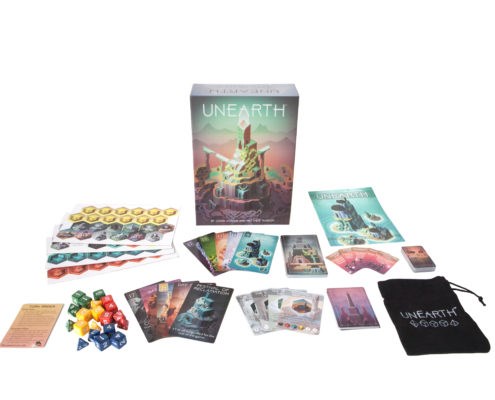Dice and I generally do not get along.
But Unearth is a game where dice are used in a rather neat way.
Unearth is a dice placement game for 2-4 players from designers Jason Harner, Matthew Ransom and Brotherwise Games, that was a pleasant surprise when it hit the table.
In part, it was the theme of the game.
“Long ago, your civilization was an empire of wonder that spanned the world – a jewel of invention and wisdom that all looked to,” detailed the rulebook.
“Then something happened, and all was ruined.
“Now you and your small tribe are trying to reclaim what was lost. To rebuild what was broken, and to remember where you came from.
“Use your Delvers well. Compete for Ruins that will give you the most points. Build the Wonders that will give your tribe the advantage. Return your people to their former glory.
“You (and your tribe of Delvers) are competing with the other players to claim the most Ruins and gather the most Stones, which are used to build Wonders.”
The core mechanic to achieve the goals is the roll of dice, which are then placed onto cards, which you hope to ultimately claim. The intrigue as a player is that not all dice are created equal. Players have a D4, D6, and D8 dice, and when to use which dice, going after which cards, lift this game to a higher level than many.
There is still the vagary associated with rolling dice, but players do have some actual choices that matter here. Often games, fun as they might be, offer choices that are very much pigeon-holed down a particular path. Here, the game play, at least ‘feels’ more free choice for players.
That feeling is helped by the fact Unearth offers multiple paths to victory.
As the rules note, ruins, (cards), are claimed by whoever has the highest die on that ruin, so rolling high can pay off.
On the other hand, stones (used to build wonders), may only be claimed by rolling low.
That facet of the game makes any dice roll useful, most of the time, which is a definite win.
Both ruins and wonders are worth points at the game’s end, so you can forge different paths to a win.
The game is also aesthetically above average, a least if you like art with a sort of modernistic look that is quite nice.
Check it out at www.brotherwisegames.com
Thanks to fellow gamers Jeff Chasse, Trevor Lyons and Adam Daniels for their help in running through this game for review.




